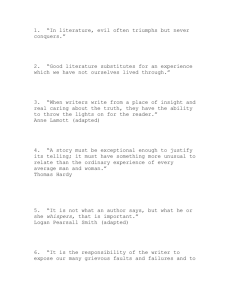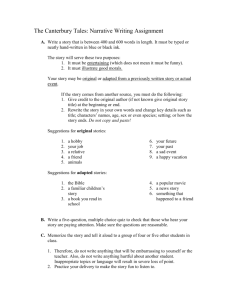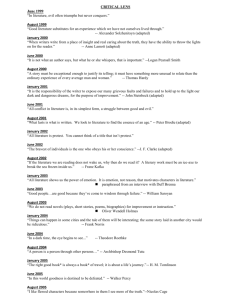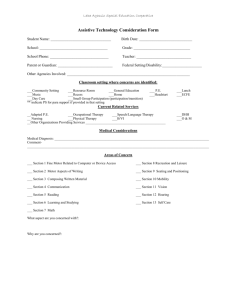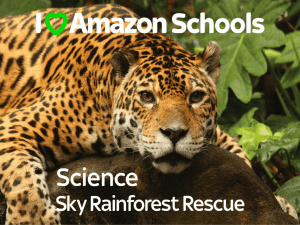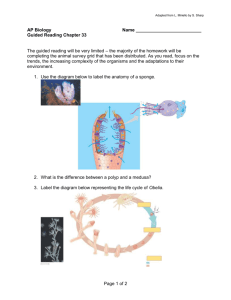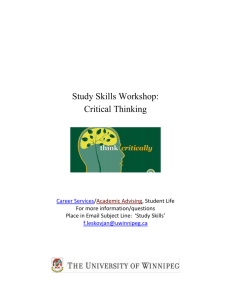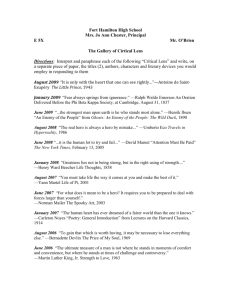Science
advertisement
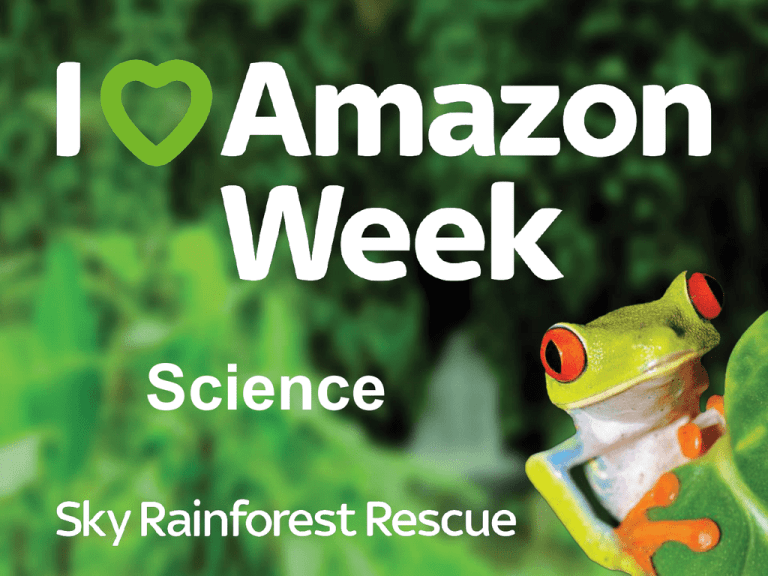
Science Adapted for life Animals can live in all sorts of different areas, from deserts to rainforests. Most animals have a particular set of conditions which they like to live in. Adapted for life A place with this set of conditions is called their habitat. You can think of it as an animal’s home. © Zig Koch / WWF Adapted for life After a species of animal has lived in a habitat with a specific set of conditions for millions of years, it’s body can begin to change, making it easier to survive there. These changes are called adaptations. Adapted for life Animals can adapt in different ways. Sometimes an adaptation will help them to find food. On other occasions it will allow them to live in extremely hot or cold conditions. Adapted for life Look at the pictures of these animals from the Amazon rainforest and try to identify what their adaptation is and how it helps them… Adapted for life Tapir Adapted for life Toucan Adapted for life Giant anteater Adapted for life Jaguar Adapted for life Spider monkey Adapted for life Tapir The tapir has developed a long flexible nose which it uses to rummage on the ground for food. Adapted for life Toucan Many of the nuts and fruits in the Amazon have developed a tough outer layer to help protect them from being eaten. This doesn’t work with a toucan though as they have developed a huge tough beak which they can use for cracking most nuts. Adapted for life Giant anteater The giant anteater has developed a long sticky tongue which it uses for extracting ants from their nests. Adapted for life Jaguar The jaguar has developed the perfect disguise for the dappled light which falls on the forest floor – it’s beautiful spotted coat! Adapted for life Spider monkey The spider monkey lives at the top of tall trees in the Amazon, almost never coming to the ground. It has developed an incredibly strong and flexible tail which it can use as an extra arm to hang from when collecting fruit. Nature trail Compare the animals you met on your nature trail to these animals which can be found in the Amazon rainforest! Nature trail The titan beetle can grow up to 16.5 centimetres long! Nature trail This blue-fanged tarantula likes to eat birds. ©Keegan Rowlinson / WWF UK Nature trail The praying mantis uses its long pincers to catch its dinner. © Zig Koch / WWF Nature trail Many of the Amazon’s frogs choose to live in trees instead of ponds! © Zig Koch / WWF Nature trail The harpy eagle is the king of the skies in the Amazon. © Zig Koch / WWF Nature trail The black caiman can grow to a massive five metres. © André / Bärtschi / WWF-Canon Food chains All living things (plants and animals) need energy to survive. Plants normally get their energy through capturing the sun’s energy (photosynthesis). Animals either need to eat plants (e.g. leaves or fruit) or other animals in order to create energy. Food chains Food chains can be used to show what eats what. For example…. Leaves Ants A food chain must always start with a plant as they catch their energy from the sun. Food chains A food chain can only travel in one direction. This direction is shown using an arrow. E.g. the monkey eats the fruit, the ocelot eats the monkey. Fruit Spider monkey Ocelot The water cycle The water cycle is the name for the journey which water takes from the sky to the earth and back again. The water cycle It relies on three really important processes: Evaporation: This is when water heats up and turns from a liquid to a gas. Condensation: The opposite of evaporation, when water turns from a gas to a liquid. Precipitation: This is water that falls from the sky. It could be in the form of rain, snow, sleet or hail. The water cycle The water cycle is really important because it keeps bringing fresh water to the land. Look at the diagram on your worksheet and see if you can attach the correct label to each part of the water cycle to show how it works. The carbon cycle All living things are made from carbon. This includes animals, trees and flowers! Carbon is even part of the air we breathe. When it is attached to oxygen it is called carbon dioxide. Plants use carbon dioxide and sunlight to grow. They absorb the carbon dioxide and turn it into carbon which they store. The carbon cycle When plants die and decompose the carbon they had stored inside them goes back into the earth. This can then be absorbed by other plants who use it to grow. It can also turn into fossil fuels although this can take millions of years. The carbon cycle When we burn fossil fuels or trees the carbon that they had stored inside them goes back into the atmosphere as carbon dioxide. This can all be shown as the carbon cycle. The carbon cycle The carbon cycle Why do you think the Amazon is so important in the carbon cycle? © Zig Koch / WWF The carbon cycle If we burn down lots of trees and fossil fuels then more carbon dioxide will go into the atmosphere. If we have destroyed lots of trees then there will also be fewer available to absorb the carbon dioxide so some will stay in the atmosphere. Carbon dioxide in the atmosphere is one of the main contributors to climate change.
